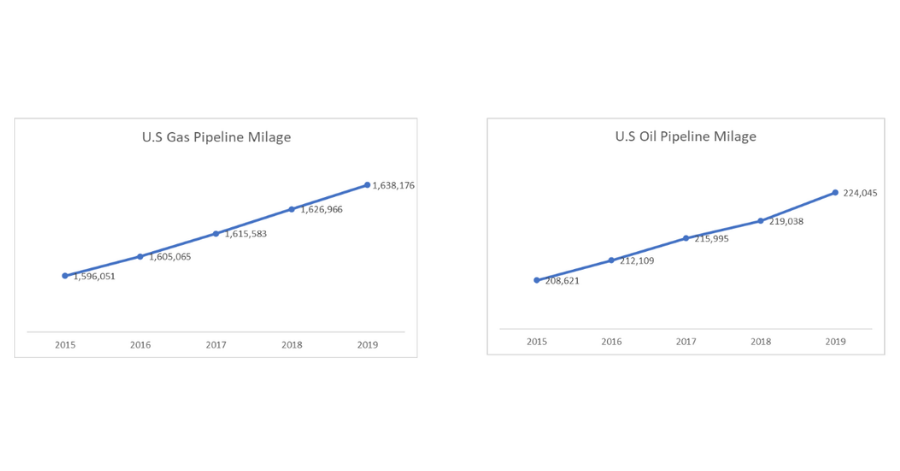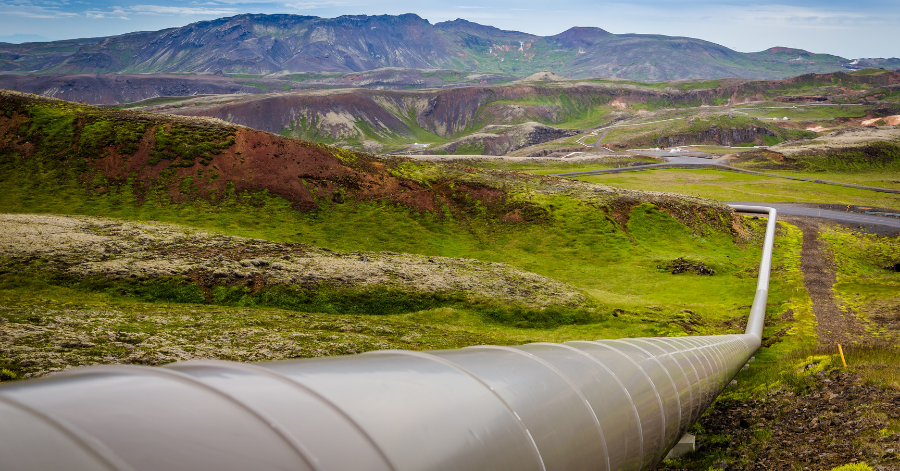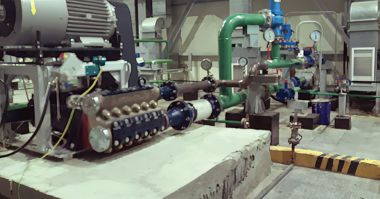North America’s Energy Outlook:
North America’s midstream oil and gas sector has been the only energy industry witnessing significant growth since the global oil price crash in 2014. The planned and the proposed greenfield and brownfield oil and gas pipelines leading to the export terminals have been the most promising opportunity for new investments and sales for stakeholders in the pipeline business.

Source: U.S Bureau of Transportation Statistics (in miles)
However, on the eve of Joe Biden’s presidential inauguration day, one of the first executive orders passed was to cancel the Keystone XL pipeline’s permits. The fate of the controversial pipeline has been hanging in the air since 2010, along with its stakeholders, with every forthcoming U.S. president undoing each others’ decisions. The key apprehension amongst the progressives behind sanctioning the pipeline, above and beyond the two political parties opposing energy policies, is that a catastrophic failure in case of a malfunction might lead to hydrocarbon spillage and the resulting adverse impact on the surrounding ecosystem
Furthermore, the new U.S. government also re-entered the international Paris Agreement, empowering EPA and enforcing Obama-era environmental regulations such as the Clean Air Act. The future of several of the earlier proposed oil and gas projects now seems bleak, with the anticipated change in energy policies leading to either further delay or cancellation. In response, the larger established energy companies spunoff new green initiatives promising to establish new ‘carbon capture and injection’ projects as an attempt to lower the company’s carbon footprint. The biggest challenge in successfully executing these large-scale initiatives countrywide is the required large capital, effort and time while remaining competitive against other global players. The current volatility in global oil prices due to overproduction and lack of demand due to COVID -19 restrictions has led to declining profit margins, making it even harder for users to allocate surplus funds towards these green initiatives.
Energy companies must act quickly with more feasible process changes to adhere to the strengthening regulation and boost consumer confidence. Today’s millennial and next-gen consumers are also very selective about the products and companies they choose to purchase and support. Taking steps to lower your company’s fugitive emissions and invest in enhanced safety to avoid potential catastrophe is a sign that your company is environmentally conscious.
Digital transformation holds the key:
Digital transformation in process industries unlocks new opportunities for owners/operators to lower fugitive emissions and optimize production operation.
Midstream oil and gas pipeline operators can leverage the latest range of intelligent valve actuators and other smart field instrumentation, paired with digital tools for asset monitoring, performance management, and proactive maintenance; over conventional products with periodic/preventive techniques to enhance operational safety and productivity.
Lowering Fugitive emissions in Gas-powered valve actuators:
Valve actuator upgrades are critical for pipeline operators striving to minimize fugitive emissions from conventional gas-powered valve actuators, which have been the ‘go-to’ technology for natural gas pipelines. One of the fundamental problems with traditional gas-powered valve actuators is the higher levels of fugitive emissions associated with their design, which exhaust natural gas into the atmosphere with each valve stroke. This leads to unnecessary costs related to product loss and potential fines for non-compliance with environmental regulations. To avoid this, end users are either completely replacing their gas-powered actuators with newer electronic actuators or retrofitting their existing units with an advanced valve operating systems designed to re-inject the extracted natural gas back into the main pipeline.
Electronic heavy-duty actuators for active condition monitoring and remote operation:
Other pipeline owners/operators are shifting away from conventional mechanical and electro-mechanical actuators in favor of more sophisticated electronic actuators to be future-ready for heavy-duty isolation applications. These smart electronic actuators are equipped with solid-state motor drives with a non-intrusive design and enhanced functionalities such as wireless control (Bluetooth), remote monitoring, data logging, and transfer capability for further analysis. These actuators can also operate on a standalone basis, independent of a central control system, and can also be autonomously powered with the aid of a solar-powered unit.
Active online corrosion monitoring for pipeline integrity
Connected non-intrusive monitoring technologies, such as acoustic emission and ultrasonic sensors, are gaining more traction in the online corrosion monitoring and leak detection space over conventional intrusive monitoring technologies.
Implementing digitally monitored and non-intrusive, real-time corrosion monitoring and leak detection systems in oil and gas midstream pipelines would reduce the frequency of inspection procedures and eliminate the need for hydrostatic testing in many applications. This would potentially reduce the periodic maintenance cost to half or one-third of the original cost incurred during the conventional inspection process.
Conclusion:
With increasing emphasis on carbon emissions across several large economies, these strategies remain valid for end-users across the globe, pursuing process optimization and lower carbon footprint. Unlike the large-scale green initiatives, end-users can choose to implement these more immediate process improvements in small segments and substantially scale it plantwide, based on desired operational changes. The companies would require considerably lower capital or can leverage leasing models for the necessary hardware and pay-as-you-go/performance-based contracts for proactive maintenance.
The scalability of renewable energy for large-scale applications is still plagued by challenges such as initial hardware cost (without federal subsidies), consistent production, storage, and distribution for completely replacing fossil fuels as a major energy source. The technology and infrastructure for the conceptual hydrogen-based energy economies are at least a few decades away from commercialization. In the transition period, the most viable source of energy is a healthy mix of renewable power generation and clean-burning fossil fuels. In the meantime, strongly promoting one’s conventional energy company as being ‘environmentally conscious also helps attract customers looking to support environmentally conscious businesses while strengthening the relationship with its existing customer base.
ARC Advisory group’s global market research reports on valve actuators, corrosion monitoring, and leak detection market reveals which technologies represent the largest share of the market, provides a detailed forecast on which regions will see the fastest growth, and explains how digitalization can enhance the overall process of valve operation, in detail. Also, ARC would like to help owner-operators assess where they are on their ‘Digital Transformation Journey.’ As part of this effort, we have developed the following survey to help us quantify the “adoption level ” of each respondent’s company, compared to their peers, to optimize the maintenance frequency, safety checks, and performance of their plant’s industrial valves. Please consider taking a few minutes to respond to ARC’s survey. Everyone who responds can view the consolidated results. https://www.surveymonkey.com/r/YKPGWXK. If you have questions about the survey, please contact us at smukunda@arcweb.com.





Comments